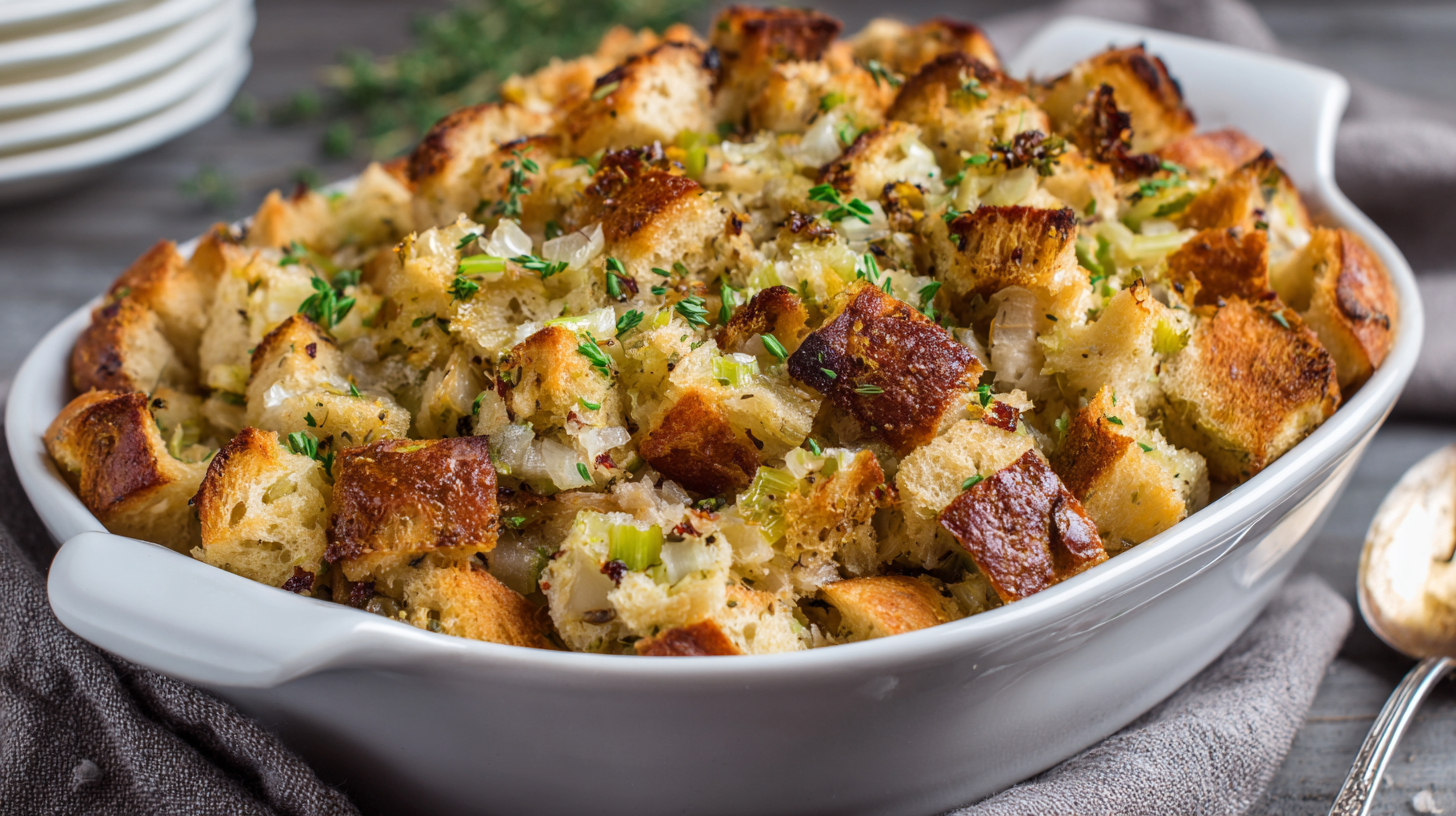The Best Easy Stuffing Recipe for Your Holiday Table
Creating the perfect stuffing doesn’t require culinary school training or hours in the kitchen. This classic recipe delivers exceptional flavor with minimal effort making it ideal for busy holiday preparations. Follow these straightforward steps to create a stuffing that will become your new tradition.
Ingredients You’ll Need
- 1 pound day-old white bread cubes (about 12 cups)
- ¾ cup unsalted butter (1½ sticks)
- 2 cups diced yellow onion (about 2 medium onions)
- 1½ cups diced celery (about 4-5 stalks)
- 3 cloves garlic minced
- ¼ cup fresh parsley chopped
- 1 tablespoon fresh sage minced (or 1 teaspoon dried)
- 1 tablespoon fresh thyme leaves (or 1 teaspoon dried)
- 1 tablespoon fresh rosemary minced (or 1 teaspoon dried)
- 1 teaspoon salt
- ½ teaspoon black pepper
- 2-2½ cups chicken broth
- 2 large eggs beaten
Step-by-Step Instructions
- Prepare the bread: If using fresh bread cut it into ½-inch cubes and spread on baking sheets. Leave out overnight to dry or bake at 250°F for 30-45 minutes until dried but not toasted. Transfer dried bread cubes to a large mixing bowl.
- Preheat your oven: Set to 350°F. Grease a 9×13 inch baking dish with butter or cooking spray.
- Sauté the aromatics: Melt butter in a large skillet over medium heat. Add onions and celery cooking for 6-8 minutes until softened and translucent. Add garlic and cook for another 1-2 minutes until fragrant.
- Combine ingredients: Pour the butter mixture over the bread cubes. Add herbs salt and pepper. Toss gently to combine ensuring all bread pieces are coated.
- Add liquid ingredients: Pour in 2 cups of chicken broth and beaten eggs. Mix carefully turning the ingredients with a large spoon or your hands until everything is evenly moistened. The stuffing should be moist but not soggy. Add additional broth if needed.
- Transfer and bake: Spoon the mixture into your prepared baking dish. Cover with aluminum foil and bake for 30 minutes. Remove the foil and continue baking for another 15-20 minutes until the top is golden brown and crispy.
- Rest before serving: Allow the stuffing to rest for 10 minutes before serving to let the flavors settle.
Make-Ahead Options
This stuffing recipe works perfectly for advance preparation. You can:
- Prepare the bread cubes up to 3 days ahead and store in an airtight container
- Chop vegetables the day before and refrigerate
- Assemble the entire dish without baking up to 24 hours in advance keep refrigerated
- Bake refrigerated stuffing adding 10-15 minutes to the covered baking time
Variations to Try
Customize this basic recipe with these delicious additions:
- Sausage Stuffing: Brown 1 pound of Italian sausage before adding the vegetables
- Fruit and Nut: Add 1 cup dried cranberries and ½ cup chopped pecans or walnuts
- Apple Stuffing: Mix in 2 cups diced apples with the vegetables
- Mushroom: Add 8 ounces of sliced mushrooms sautéed with the vegetables
- Cornbread: Replace half the white bread with cornbread for a Southern twist
Your holiday table deserves this reliable easy stuffing that delivers perfect results every time. The combination of buttery bread savory herbs and aromatic vegetables creates the ideal companion for roasted turkey or chicken without complicated techniques or hard-to-find ingredients.
Why This Easy Stuffing Recipe Works
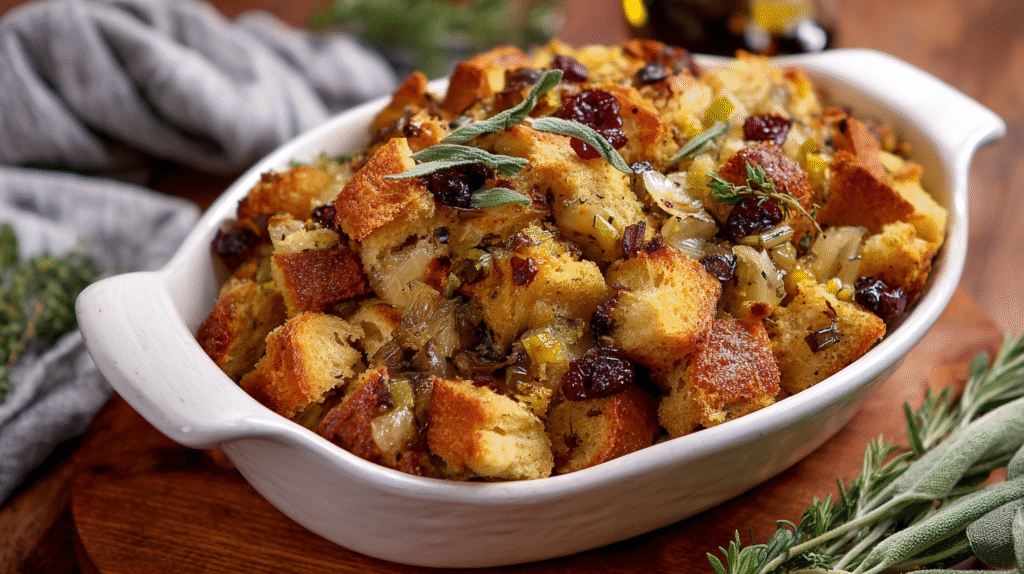
This homemade stuffing recipe stands out from store-bought versions for several compelling reasons. Perfect bread texture comes from using day-old bread that maintains structure while absorbing flavors. The combination of butter and aromatics creates a flavor foundation that makes this recipe foolproof.
Unlike complicated alternatives this stuffing achieves the ideal balance of moisture. It remains moist inside while developing crispy golden edges that everyone fights over. The herb blend provides classic Thanksgiving flavors without requiring specialty ingredients.
Flexibility makes this recipe particularly appealing for busy holiday cooks. You can prepare components ahead of time and customize with add-ins based on your preferences. The straightforward technique works whether you’re cooking for a large gathering or intimate dinner.
The texture contrast between the crisp top layer and tender interior delivers satisfaction in every bite. By toasting the bread cubes beforehand you ensure they hold up to the moisture without becoming soggy. This simple approach eliminates common stuffing problems like mushiness or dryness.
Each ingredient serves a purpose in this well-tested recipe. Celery provides subtle crunch while onions deliver sweetness when properly sautéed. The garlic and herbs infuse throughout creating depth without overwhelming the palate. Your guests will immediately recognize these traditional flavors yet appreciate the superior execution.
Key Ingredients for Homemade Stuffing
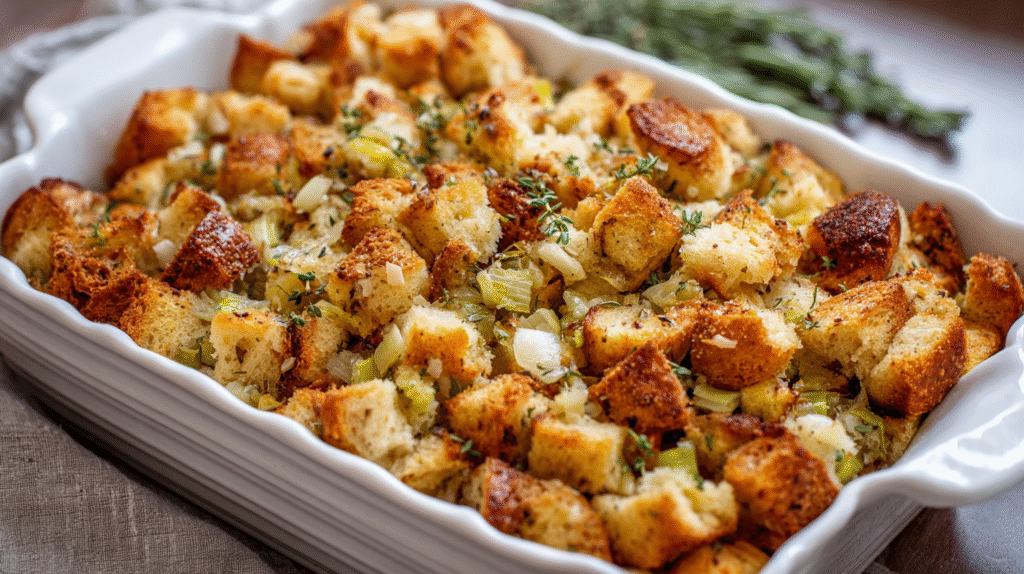
Creating delicious homemade stuffing starts with selecting the right ingredients. Each component plays a crucial role in building those classic flavors and textures that make stuffing the star of any holiday table.
Bread Options
The foundation of any great stuffing begins with bread. Day-old bread works best as it absorbs moisture without becoming soggy. White sandwich bread produces a soft classic stuffing while sourdough adds tanginess and complexity to your dish. French or Italian bread creates a more rustic texture with its chewy interior and crisp crust. Cornbread brings a touch of sweetness and crumbles beautifully for a Southern-style variation. For a heartier option try whole grain breads which contribute nutty flavors and additional texture. Cut your chosen bread into ½-inch cubes and dry them out either by leaving them uncovered overnight or toasting them in the oven at 250°F for about 30 minutes.
Herbs and Seasonings
Herbs deliver the signature aroma and flavor profile that defines traditional stuffing. Fresh sage offers earthy pungent notes that most people immediately associate with Thanksgiving meals. Thyme contributes subtle floral elements while rosemary adds distinctive pine-like fragrance. Parsley brings brightness and color to balance the deeper herb flavors. For the seasoning base poultry seasoning blends together many complementary herbs in one convenient mix. Salt and freshly ground black pepper are essential for improving all the other flavors. Consider adding a pinch of nutmeg or a dash of cayenne for unexpected depth. Fresh herbs provide the most vibrant flavor but dried herbs work well too – just remember to use about one-third the amount of dried herbs compared to fresh.
Vegetables and Aromatics
The aromatic vegetable base forms the flavor foundation of exceptional stuffing. Onions and celery create the classic mirepoix that provides sweetness and texture. Garlic adds depth and complexity when sautéed with the other aromatics. Leeks offer a milder onion flavor that works beautifully in more delicate stuffing variations. For moisture and richness good quality broth serves as the binding element – chicken broth is traditional but vegetable or turkey broth work equally well. Butter contributes essential richness and helps brown the vegetables to develop their flavors. Some cooks add diced carrots for subtle sweetness and color. For maximum flavor sauté these vegetables until soft and fragrant before combining them with your bread cubes. This vegetable mixture distributes flavor throughout each bite of your finished stuffing.
Equipment Needed
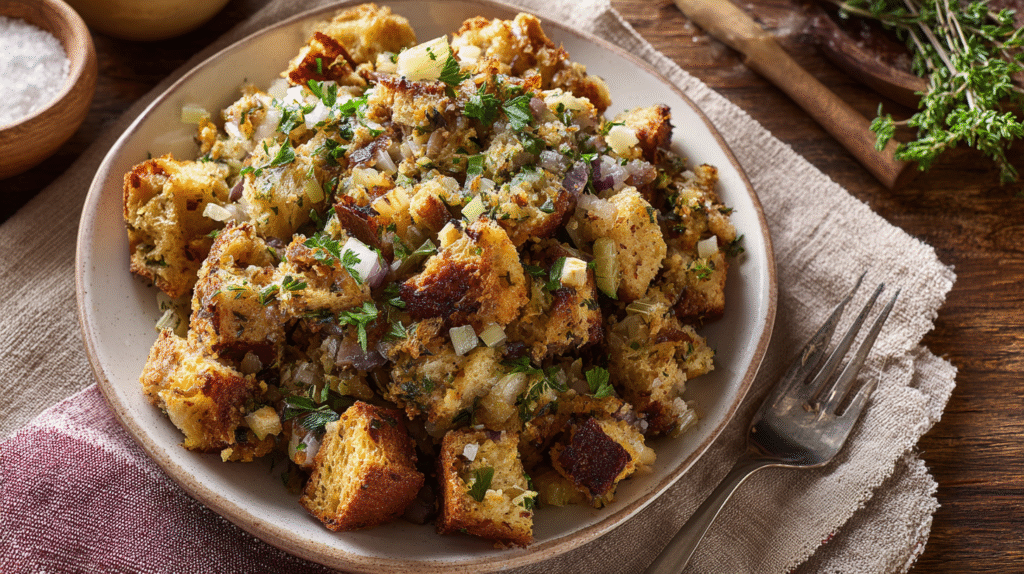
Creating this easy stuffing recipe requires minimal kitchen equipment that most home cooks already have on hand. Gather these basic tools before starting:
- Large mixing bowl (for combining all ingredients)
- Cutting board and sharp knife (for chopping vegetables and bread)
- Measuring cups and spoons (for accurate ingredient portions)
- Large skillet or sauté pan (for cooking vegetables)
- Wooden spoon or spatula (for stirring)
- 9×13 inch baking dish or casserole dish (for baking the stuffing)
- Aluminum foil (for covering during baking)
Your baking dish selection matters for achieving the perfect texture. A standard 9×13 inch dish works well for serving 8-10 people and creates a nice balance of crispy top and moist interior. Deeper dishes produce more soft stuffing while shallower ones yield more crispy edges.
For best results when sautéing vegetables use a heavy-bottomed skillet that distributes heat evenly. This ensures your onions and celery cook uniformly without burning.
Keep your wooden spoon or heat-resistant spatula handy both for cooking vegetables and folding ingredients together in your mixing bowl. These tools help incorporate everything gently without crushing bread cubes.
Non-stick cooking spray or additional butter will prevent your stuffing from sticking to the baking dish during cooking and serving. Apply it generously to all sides of your baking dish before adding the stuffing mixture.
How to Make Easy Homemade Stuffing
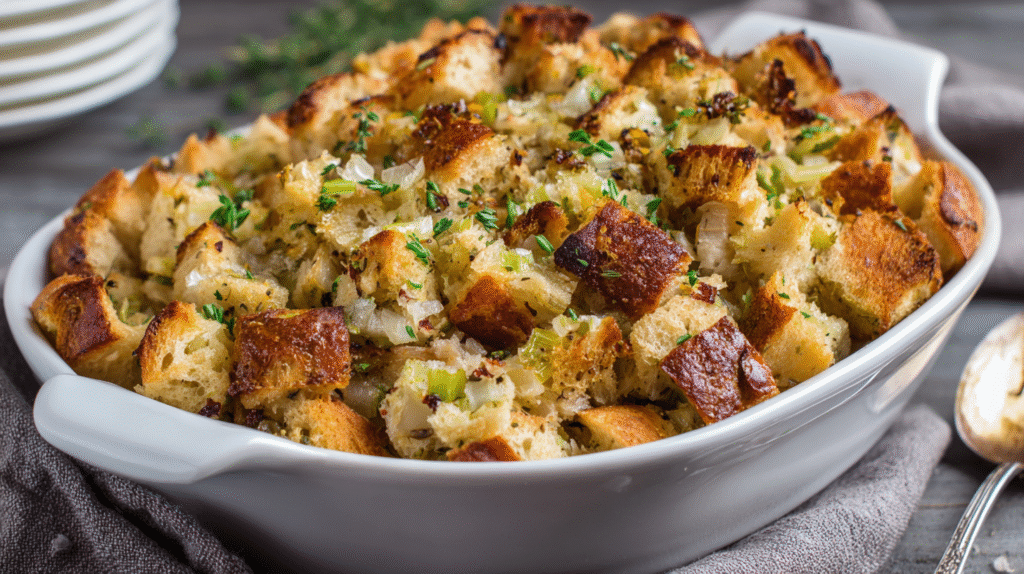
Creating homemade stuffing is simpler than you might think. Follow these step-by-step instructions for a foolproof side dish that will impress your holiday guests.
Preparing the Bread
Start by cutting your day-old bread into 1-inch cubes. Spread the bread cubes in a single layer on baking sheets and let them dry out at room temperature for 12-24 hours. For a quicker method, toast the bread cubes in a 250°F oven for 30-45 minutes until they’re completely dry but not browned. Properly dried bread cubes absorb the flavorful liquid without becoming soggy. You’ll need about 12 cups of bread cubes for a standard recipe serving 8-10 people. Different bread varieties will yield slightly different textures – white bread creates a softer stuffing while sourdough or whole grain options provide more chew and flavor.
Sautéing the Aromatics
Melt 3/4 cup butter in a large skillet over medium heat. Add 2 cups diced onions and 1 1/2 cups diced celery to the melted butter. Sauté these vegetables for 6-8 minutes until they’re soft and translucent but not browned. Add 4 minced garlic cloves during the final minute of cooking and stir until fragrant. The aromatics form the flavor foundation of your stuffing so don’t rush this step. Your kitchen should fill with an irresistible savory aroma that signals you’re on the right track. This mixture provides moisture and richness that transforms plain bread into spectacular stuffing.
Combining the Ingredients
Transfer your sautéed aromatics to a very large mixing bowl. Add the dried bread cubes to the bowl with the butter-vegetable mixture. Sprinkle in 1/4 cup chopped fresh parsley 1 tablespoon fresh sage 2 teaspoons fresh thyme leaves and 1 teaspoon fresh rosemary. Season with 1 teaspoon salt and 1/2 teaspoon black pepper. Pour 2 1/2 to 3 cups warm chicken or vegetable broth over the mixture gradually while gently tossing. The stuffing should feel moist but not soggy – add more broth if it seems dry. Fold everything together carefully using a large spatula or your hands to avoid crushing the bread cubes. Taste and adjust seasonings as needed before transferring to your baking dish.
Baking the Stuffing
Preheat your oven to 350°F. Transfer the stuffing mixture to a buttered 9×13 inch baking dish. Cover the dish with aluminum foil and bake for 30 minutes. Remove the foil and continue baking for another 15-20 minutes until the top is golden brown and crispy. The internal temperature should reach 165°F for food safety. Check the stuffing halfway through the uncovered baking time – if the top is browning too quickly cover it loosely with foil. Let the stuffing rest for 10 minutes before serving to allow the flavors to settle and make serving easier. Your perfectly baked stuffing should have a crispy golden top with a moist tender interior that holds together when served.
Make-Ahead Instructions
Holiday meal prep becomes significantly easier when you prepare components in advance. This stuffing recipe is perfect for making ahead using one of these methods:
Prepare 1 Day Ahead (Recommended)
- Follow all preparation steps through combining bread cubes with the vegetable mixture and herbs
- Add broth until just moistened but do not bake
- Cover tightly with plastic wrap or aluminum foil
- Refrigerate for up to 24 hours
- When ready to bake, remove from refrigerator and let sit at room temperature for 30 minutes
- Add additional broth if needed (mixture may have absorbed liquid overnight)
- Bake according to original instructions, adding 5-10 minutes to the covered baking time
Freeze Unbaked Stuffing
- Prepare stuffing completely but do not bake
- Transfer to a freezer-safe baking dish
- Cover tightly with plastic wrap then aluminum foil to prevent freezer burn
- Label with date and freeze for up to 1 month
- Thaw overnight in refrigerator before baking
- Let stand at room temperature for 30 minutes
- Check moisture level and add additional broth if needed
- Bake according to recipe instructions, adding 15 minutes to total baking time
Freeze Baked Stuffing
- Prepare and bake stuffing completely
- Allow to cool completely to room temperature
- Portion into freezer-safe containers or bags
- Freeze for up to 2 months
- Thaw overnight in refrigerator
- Reheat covered in a 350°F oven until warmed through (about 30 minutes)
- Uncover for the last 10 minutes to crisp the top
These make-ahead options ensure you spend less time in the kitchen on the big day while still enjoying fresh homemade stuffing. The day-ahead method produces results nearly identical to same-day preparation and actually allows flavors to meld beautifully overnight.
Storing and Reheating Leftover Stuffing
Properly storing and reheating your homemade stuffing ensures you can enjoy those delicious flavors for days after your holiday meal. Follow these guidelines to maintain the texture and taste of your leftover stuffing.
Refrigerating Leftover Stuffing
Store cooled stuffing in airtight containers within two hours of cooking to prevent bacterial growth. Your refrigerated stuffing will stay fresh for up to 4 days when properly stored. For best results divide large amounts into smaller portions which cool faster and maintain better quality. Always make sure your stuffing has reached room temperature before refrigerating to prevent condensation that could make it soggy.
Freezing Stuffing for Longer Storage
Freeze leftover stuffing when you need to preserve it beyond a few days. Place completely cooled stuffing in freezer-safe containers or heavy-duty freezer bags, removing as much air as possible. Label containers with the date as frozen stuffing maintains best quality for up to 3 months. Portion your stuffing before freezing so you can thaw only what you need for future meals.
Best Methods for Reheating Stuffing
Oven Method (Recommended)
- Preheat your oven to 350°F
- Transfer stuffing to an oven-safe dish
- Add 2-3 tablespoons of broth or butter per cup of stuffing to restore moisture
- Cover with foil and bake for 20 minutes
- Remove foil and bake an additional 10-15 minutes for a crispy top
Microwave Method (Quick Option)
- Place a portion of stuffing in a microwave-safe dish
- Sprinkle 1-2 tablespoons of broth or water over the stuffing
- Cover with a microwave-safe lid or paper towel
- Heat on medium power for 2-3 minutes
- Stir and continue heating in 30-second intervals until heated through
Stovetop Method
- Melt 1-2 tablespoons of butter in a skillet over medium heat
- Add stuffing to the pan and break up any large chunks
- Drizzle with 1-3 tablespoons of broth
- Cover and heat for 3-5 minutes stirring occasionally
- Remove lid and cook for an additional 2-3 minutes for crispy edges
Signs Your Leftover Stuffing Has Spoiled
Trust your senses when determining if stuffing is still safe to eat. Discard stuffing that shows any signs of mold growth visible as fuzzy green or white spots. A sour smell or off odor indicates bacterial growth making the stuffing unsafe for consumption. Changes in texture like excessive sliminess or unusual stickiness suggest spoilage has occurred. Your leftover stuffing should maintain its original color; any discoloration points to potential spoilage.
Creative Ways to Use Leftover Stuffing
Transform leftover stuffing into stuffing waffles by pressing cold stuffing into a waffle iron for a crispy breakfast base topped with eggs and gravy. Form cold stuffing into patties then pan-fry them until golden for delicious stuffing cakes that pair perfectly with leftover turkey. Add stuffing to beaten eggs with some milk to create a unique breakfast casserole with holiday flavors. Stuff mushroom caps or bell peppers with your leftover stuffing then bake until hot for an easy appetizer or light lunch option.
Variations to Try
While the basic stuffing recipe is delicious on its own, these creative variations will help you customize your dish to suit different tastes and occasions. Each option maintains the essential elements of great stuffing while introducing unique flavor combinations.
Classic Herb Stuffing
The classic herb stuffing emphasizes traditional flavors with an elevated herb profile. Add extra fresh herbs like sage, thyme, rosemary and parsley—about 3-4 tablespoons total of finely chopped herbs. You can enhance the savory notes by incorporating 1/4 cup of grated Parmesan cheese into the mixture before baking. For additional texture, mix in 1/2 cup of toasted chopped walnuts or pecans. This variation pairs wonderfully with turkey and chicken dishes, offering familiar comfort food flavors with a sophisticated twist that guests will recognize as the quintessential holiday stuffing.
Sausage and Apple Stuffing
Transform your basic stuffing into a hearty main-dish contender by adding protein and fruit. Brown 1 pound of Italian sausage (casings removed) until fully cooked, then drain excess fat before adding to your bread mixture. Incorporate 2 medium apples (Honeycrisp or Granny Smith work best), peeled and diced into 1/2-inch cubes, for a pleasant sweetness that balances the savory sausage. You might also add 1/3 cup of dried cranberries for tart pops of flavor and 1/2 cup of chopped fennel for a subtle anise undertone. This robust variation creates a delicious sweet-savory contrast that makes it a standout side dish at any feast.
Cornbread Stuffing
Create a Southern-inspired stuffing by substituting half or all of the regular bread with crumbled cornbread for a slightly sweet, distinctive texture. Prepare cornbread a day ahead or use store-bought varieties for convenience. Add 1/2 cup of diced red bell pepper and 1 diced jalapeño (seeds removed) for color and mild heat. Incorporate 6-8 slices of cooked and crumbled bacon for smoky depth and 1 cup of corn kernels (fresh or frozen) for sweet pops of flavor. This variation pairs exceptionally well with smoked or barbecued meats, bringing a touch of Southern comfort to your holiday table with its unique cornbread foundation.
Serving Suggestions
Your homemade stuffing deserves to be showcased properly on your holiday table. Serving this versatile side dish correctly enhances both its presentation and flavor profile while complementing your main course perfectly.
Transfer your golden-brown stuffing to a decorative serving bowl or platter before bringing it to the table. A ceramic or earthenware dish helps maintain the stuffing’s warmth throughout the meal. Garnish with fresh herb sprigs like sage or thyme just before serving to add a pop of color and hint at the flavors inside.
This easy stuffing recipe pairs exceptionally well with traditional holiday proteins. Serve alongside roasted turkey as a classic Thanksgiving combination or with baked ham for Easter gatherings. Roast chicken benefits from this savory side year-round for Sunday family dinners.
Consider offering gravy alongside your stuffing for guests who enjoy extra moisture and richness. A small gravy boat placed next to the stuffing allows everyone to customize their portion. The savory gravy soaks into the bread cubes creating an irresistible flavor combination.
Balance your plate by adding colorful vegetable sides when serving stuffing. Bright green beans cranberry sauce or roasted root vegetables provide textural and flavor contrasts that highlight the stuffing’s herbal notes. This creates a visually appealing and nutritionally complete meal.
For casual gatherings transform leftover stuffing into individual portions. Spoon warm stuffing into ramekins or muffin cups for personalized servings that maintain their heat longer. This presentation style works particularly well for buffet-style meals or when hosting larger groups.
Remember that stuffing continues to absorb flavors as it sits making it an excellent make-ahead dish. The herbs and aromatics develop deeper complexity when allowed to meld overnight then gently reheated before serving at your holiday feast.
The Perfect Stuffing Every Time
This easy stuffing recipe puts holiday side dish perfection within your reach. You’ll love how it delivers that ideal balance of crispy exterior and tender interior that store-bought versions simply can’t match.
With just a few pantry staples and simple techniques you can create a memorable dish that guests will rave about. Whether you stick with the classic version or explore the variations we’ve shared your homemade stuffing will become a cherished tradition.
Remember you can prepare it ahead of time to reduce holiday stress and even transform leftovers into creative new dishes. Now you’re ready to confidently serve a stuffing that perfectly complements your holiday feast while making the most of your time in the kitchen.

